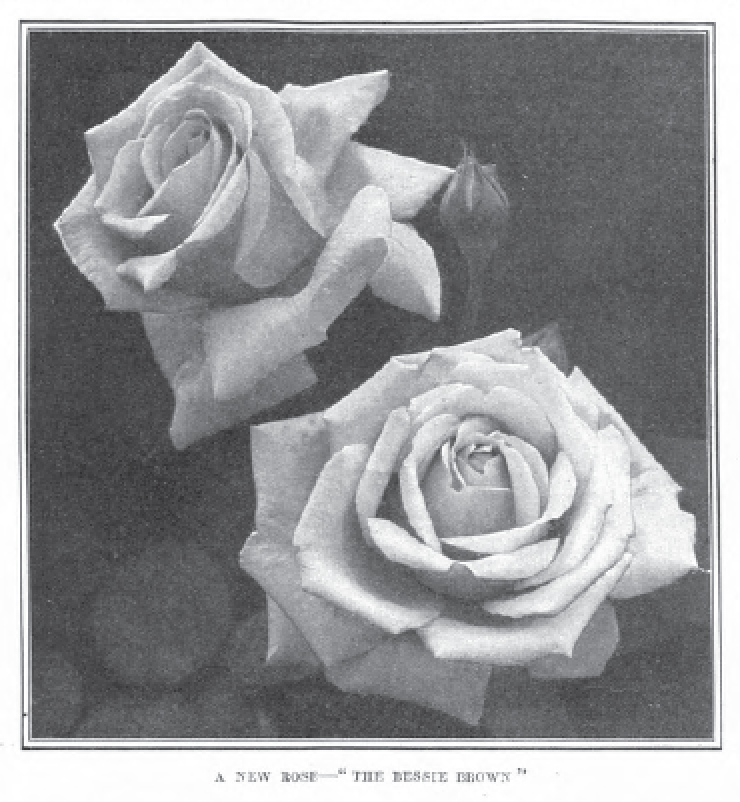Planting a rose garden.
Hamilton, Samuel Armstrong. "Planting a rose garden." Harper's Bazaar 46, no. 6?
(June 1912): 306.
[https://library-projects.providence.edu/rosarium/view?docId=tei/rg0071.xml]

Roses will grow and give some kind of returns in any good well-drained soil, but will amply and richly reward her who gives them intensive culture. You go to the exhibitions and admire the beautiful roses displayed there, and wish you could grow such yourself! You can, by the same method of culture and with no more labor than by the old-time slack methods. The principles are the same whether you grow a small bed or a large garden full of beds and borders.
In growing roses the aim should be toward permanent beds and borders, as in these there is sure to be good drainage and a made soil of known quality. This may seem like a good deal of work, but keep in mind that permanent beds and borders, once made, are made for life, and you get the same fine results every year. They should be excavated to the sub-soil, taking two inches of the latter as you go, keeping all the good soil to one side, and having separately all the stones to be used for drainage. If the bed or border is on the level, slope the bottom toward one end, making it three inches lower than the other. In the care of a circular bed (the poorest shape for rose-beds) grade from the outside to the center, making the latter three inches higher.
In the bottom of the excavation put two to three inches of stone broken to the size of railroad ballast, according to the depth, and grade it evenly. On this the soil should be put some time before the planting to allow it to settle.
The soil for the rose-beds and borders should be specially made, as it is intended to last a long time. The base may be good garden loam, to which should be added its bulk of sods from the roadside, especially white-clover sod, which usually can be had in plenty. You can use all sod to good advantage, if obtainable, omitting the garden loam; if both are used, chop the sod fine, and mix with the loam. To this add half of its bulk of well-rotted cow-manure. Use no green manure of any kind in beds and borders, as much harm can be caused thereby. Cow-manure is the best for roses, and that from a stable in which leaves are used as bedding is better than any other. It should be made fine, and loose, and be well mixed with the sods and soil.
If the season is well advanced, a good way to settle the soil in the excavation is to fill in several inches, give it a light soaking with the hose, and repeat. By the time all is in it will be settled and ready for planting. When the top-layer of soil is put on, before raking, give it as much bone-flour as will whiten the soil and a similar quantity of powdered lime, and rake the bed even and smooth. Roses must have lime to give vivid color.
The rose which gives the greatest returns in beauty and number of flowers is the hybrid tea. North of New York they are not hardy even with protection, but south of that they can be held out in the open ground all winter by giving protection according to your latitude. The best protection is to drive three stakes in the ground as high as the top of the bush. Tie them together at the top, and tack tar building-paper over them, which will insure ventilation and keep off ice.
A number of fine hybrid tea-roses have been introduced for the season of 1912, among which are: "Betty," coppery rose; "Dorothy Page Roberts, " light coppery pink and apricot; "Duchess of Wellington," saffron, yellow, crimson; "Duchess of Westminster," clear rose, madder; "Elizabeth Barnes," satiny salmon rose; "Ferniehurst," coppery pink or fawn; "Florence Edith Coulthwaite," deep cream, suffused rose; "F. R. Patzer," creamy buff; "Grace Molyneux," creamy apricot; "James Coey," deep yellow; "Château de Clos Vougeot" , rich scarlet.
There are fewer novelties in the hardy perpetual garden class than in any of the others. We have not had a good new one for ten years until this year, when we get the following three: "George Arends," tender rose, form of the famous "Frau Druschki" ; "Gloire de Chedane Guinoisseau," velvety vermillion red; "President Kruger," crimson scarlet, shaded black. We also have three fine new Austrian briers: "Juliet," back of petals old gold, interior rosy red; "Rayon d’Or," golden yellow; "Soleil d’Or," reddish gold. The above are deliciously fragrant.
There are two new baby-ramblers, which are fine for low hedges as they bloom from June until killed by frost: "Jessie," cherry red; "Orleans," geranium red. The best of the new tall ramblers are: "Delight," bright carmine; "Excelsa," crimson maroon. There are two new pillars which are worthy of a post in every garden: "American Pillar," soft pink with white eye; "White Dorothy," a white form of the popular "Dorothy Perkins" pillar.
Roses in beds or borders should not be crowded; give them a foot of space all around the bushes, and they will give better results. They require watering often and thoroughly—not merely sprinkling the top of the soil. The drainage will prevent over watering, so be generous with the water during the hot, dry months of midsummer.

